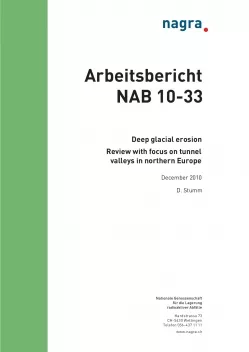
Arbeitsbericht NAB 10-33
Deep glacial erosionReview with focus on tunnel valleys in northern Europe
Tunnel valleys that formed during the past millions of years have been described from various parts of the world. On a smaller scale, recent tunnel valley formation has been documented. This literature review focuses on tunnel valleys in northern Europe formed during the Pleistocene and describes tunnel valley morphologies, valley distribution, bedrock lithology, formation processes and formation rates. Tunnel valleys are large, overdeepened incisions that appear as individual several kilometre long segments or as network like systems with total length up to > 150 km. Widths of tunnel valleys range between a few hundred metres and a couple of kilometres, in some cases up to 6 km. Typical depths of tunnel valleys range from a few decametres up to a few hundred metres. In the reviewed literature, only very few tunnel valleys reach depths of more than 500 m, which are cut into very soft sediments in northern Germany and in the North Sea. Tunnel valleys often begin and terminate abruptly and are steep-sided with wide and relatively flat bottoms. The longitudinal profile is often described as undulating, with sills, steps, a reverse gradient, or as concave. There are open and buried tunnel valleys, where open tunnel valleys are occasionally occupied by lakes, bogs or eskers, and buried tunnel valleys are filled with glaciogenic, glacio.fluvial, glaciolacustrine, glaciomarine or non-glacial sediments. Tunnel valleys are oriented in a parallel or radial pattern, and are inferred to be parallel to the hydraulic potential gradient mostly at past ice sheet margins. At notches in the ice margin where two ice lobes meet tunnel valleys develop preferably. Some tunnel valleys in the North Sea possibly formed at an ice sheet central location. Tunnel valleys often end at terminal moraines, where the eroded material is deposited onto an outwash fan or sandur. Formation processes influence the morphology and distribution of tunnel valleys. Several generations of overlying and cross-cutting tunnel valleys have been observed, which formed independently from preexisting tunnel valleys and their infill material. Such cross-cutting tunnel valleys appear as anastomosing valleys systems. The under.lying lithology of tunnel valleys in northern Europe consists of unlithified Quaternary sediments and Cenozoic sedimentary rocks, such as sandstone, siltstone, claystone, limestone or chalk. The overall distribution of tunnel valleys roughly relates to the lithology of the substrate, and its mechanical characteristics and ability to modulate pore pressure. Thereby, in general, non-lithi.fied sediments seem to be most susceptible to tunnel valley formation, but also weakly lithified sedimentary rocks often host considerable tunnel valleys. Locally, tectonic features such as salt domes influence bedrock lithology and thereby can (but do not have to) deflect tunnel valleys.
The most important formation processes involve subglacial meltwater erosion, whereby most likely tunnel valleys form by a combination of processes, including direct glacial erosion. The reviewed meltwater erosion processes include time-transgressive formation, catastrophic melt.water drainage, megafloods and sediment deformation. Time-transgressive formation is characterised by temporally transgressing and spatially regressing erosion, in some cases in con.junction with glaciohydraulic supercooling. Catastrophic outburst events or jökulhlaups require a water reservoir that drains suddenly, such as subglacial meltwater that is dammed behind a cold based glacier margin and catastrophically released when the ice margin becomes permeable. Megafloods, though controversial, are thought to produce tunnel valleys as a by.product of widespread subglacial sheet floods that channel temporally. Sediment deformation is based on the liquefaction of sediments that are evacuated by meltwater. The sediments are de.formed under low effective pressure either in water-filled subglacial channels causing sediment creep, or in gradually developing pipes. Direct glacial erosion includes quarrying/plucking and abrasion, and is usually considered to contribute to tunnel valley formation only in combination with other processes. Erosion rates are difficult to estimate, on the one hand because they depend on the considered timeframe and whether phases of inactivity can be identified, and on the other hand because the rare observations concern mainly catastrophic outburst floods.
